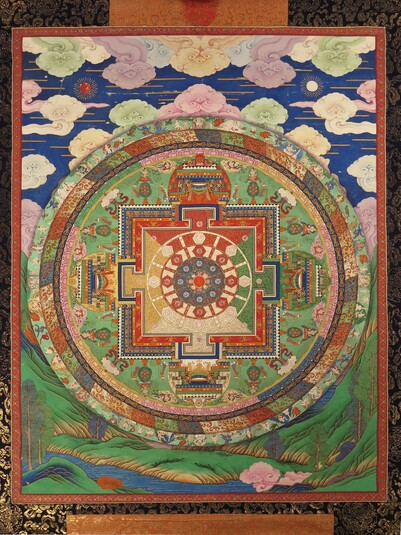
Item: Mandala of Vajrayogini (Buddhist Deity) - Vajravarahi
| Origin Location | China |
|---|---|
| Date Range | 1700 - 1799 |
| Lineages | Gelug and Buddhist |
| Material | Ground Mineral Pigment on Cotton |
| Collection | Private |
Classification: Deity
Appearance: Semi-Peaceful
Gender: Female
Vajravarahi Thirty-seven Deity Mandala from the Vajravali compendium of Tantric practices. This is the twenty-second practice from approximately forty-four different mandalas spanning all four Tantra classification sets of the Vajravali. (See the list of mandala deities).

The mandala is without any deity figures. In place of the deities are Tibetan letters representing the seed syllables of the thirty-seven deities. Compositions such as this are called symbol mandalas and are a graphically more simple style in rendering mandalas in art. They are equal in meaning and function to mandala paintings that depict all of the figures described in the elaborate Tantric ritual. (See the Outline Page called What are Mandalas?).
This composition belongs to a larger set of paintings commissioned by the 12th prince, Yintao (1686-1763), son of the Kangxi Emperor (1654-1722). Yintao was an uncle of the Yongzheng Emperor (1678-1735).
The set of paintings were likely commissioned sometime between 1750 and 1763. Two other compositions are known in American collections. Three additional compositions are in Japan and belong to a university museum.
The line of text along the front bottom of the painting gives the information identifying the donor and further states that the mandala was drawn according to the measurements of Changkya Rolpa'i Dorje (1717-1786). Changkya was a Buddhist teacher for both Yintao and the Qianlong Emperor (1711-1799).
The central mandala while appearing to follow strict Buddhist and Newari iconometric measurements and style deviates in many small ways to accomodate a Beijing imperial taste. The surrounding landscape is completely out of character for most Himalayan style art and also follows the dictates of current Beijing painting style of the mid 18th century.
Front lower inscription: “Based on the instructions for mandala iconometry by Changkya Trulku Rinpoche this Vajramala mandala was offered with pure intention by the 12th Prince Yintao.”
Jeff Watt 6-2014
(For more information see the publication Empire of Emptiness: Buddhist Art and Political Authority in Qing China by Patricia Ann Berger. Pages 186-187. University of Hawai'i Press, 2003).
Front of Painting
English Translation of Inscription: Ribbon Inscription: The Red Vajravarahi Thirty-seven Deity Vajravali mandala.
Front Top: Homage to the Red Vajravarahi Thirty-seven Deity Vajravali mandala.
Wylie Transliteration of Inscription: Front Top: rdo rje ''''''''''''''''''''''''''''''''phreng ba''''''''''''''''''''''''''''''''i dkyil ''''''''''''''''''''''''''''''''khor nyer g.nyis pa rdo rje phag mo dmar mo lha sum cu so bdun gyi dkyil ''''''''''''''''''''''''''''''''khor la na mo.
Front Bottom: lcang skya sprul sku rin po ches thig sogs kyi bkod pa gnang nas rgyal sras bcu nyis pa yun tho''''''''''''''''''''''''''''''''u gyi lhag bsas dag pas phul pa''''''''''''''''''''''''''''''''i rdor phreng gi dkyil ''''''''''''''''''''''''''''''''khor.
Ribbon inscription: rdo rje ''''''''''''''''''''''''''''''''phreng ba''''''''''''''''''''''''''''''''i dkyil ''''''''''''''''''''''''''''''''khor nyer g.nyis pa rdo rje phag mo dmar mo lha sum cu so bdun gyi dkyil ''''''''''''''''''''''''''''''''khor.
Reverse of Painting
Special Features: (Printed script (Uchen))
Publication: Zhiguan Museum (Article)
Thematic Sets
Publication: Zhiguan Museum (Chinese Language Article)
Buddhist Deity: Vajrayogini, Vajravarahi Main Page
Buddhist Deity: Vajravarahi Mandalas
Subject: Vajravali Main Page
Subject: Vajravali Painting Set Page
Collection of Zhiguan (Painting & Textile)
Region: China (Museums & Monasteries)
Painting Style: Qianlong Period Painting Style
Painting Style: Chengde (China)
Collection: Christie's, Painting & Sculpture (September, 2014; NY)
Collection of Zhiguan Museum of Fine Art
Buddhist Deity: Vajrayogini, Varahi (Mandala Masterworks)
Mandala: Masterworks Page
Region: China, Mandala Masterworks
Mandalas: Secrets in Identification
Buddhist Deity: Vajrayogini, Vajravarahi Religious Context




